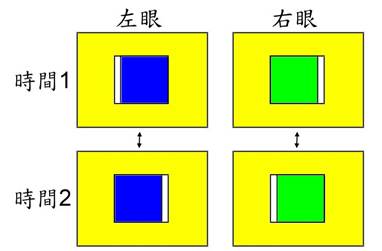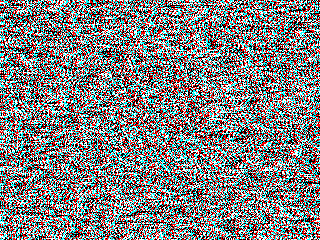Random-dot
Correlogram, RDC
Spatial
RDC and Temporal RDC
Ai-Hou Wang, MD. PhD.
(Some
images in this article require red-blue glasses. Right eye blue lens, left eye
red lens.)
製作隨機點立體圖(Random-dot Stereogram,
RDS)的方法如圖,兩眼所見的背景(黃色)是相同的隨機點花樣。另選一個點數百分比一樣的隨機點正方形(藍色),稍微偏左一點貼上右眼的隨機點背景,偏右一點貼上左眼的隨機點背景。
The
method for creating a random-dot stereogram (RDS) is shown in the figure. The
background seen by both eyes (yellow) is the same random dot pattern. Select
another square of random dots (blue) with the same dot percentage and slightly
offset to the left for the right eye's random dot background and slightly
offset to the right for the left eye's random dot background.

因為點數百分比相同,方形融進背景,單眼看不到方形。但是兩眼同時看,人的大腦有能力發現兩眼位置稍微岔開的方形
(大腦是如何發現方形的?),並且看出方形浮出於背景之前,這就是立體視(Stereopsis)。
Because
the percentage of points is the same, the square merges into the background,
and it cannot be seen with one eye.However, when
looking with both eyes, the human brain can detect the square whose positions
are slightly different between the two eyes (how does the brain detect the
square?), and see that the square emerges from the background.This
is stereopsis.
傳統的立體圖,單眼就有可見的圖形。對產生立體視的機制是這樣講的:(1)兩眼先融合(fuse)這個圖形,(2)發現兩眼的圖形位置不完全相同,有像差(disparity)存在,(3)大腦將這個像差轉換為深度的知覺(depth
perception)。
Traditional
3D images, the image is visible with one eye. The mechanism for generating
stereoscopic vision is described as follows: (1) first fuse the image with both
eyes, (2) find that the image positions of the two eyes are not exactly the same, and there is disparity, (3) the brain
converts this disparity into depth perception.
隨機點立體圖單眼並沒有可見的圖形,上述產生立體視的機制的第一步便不成立,新的機制是(1)先融合兩眼的隨機點花樣,(2)發現其中有個方形區域,同時兩眼所見的方形區域之間存在著像差,(3)將方形的像差轉換為深度的知覺。
Randomly-placed
stereoscopic monocular displays do not have any visible patterns, so the first
step of the mechanism described above for generating stereopsis does not apply.
The new mechanism is (1) to first fuse the random dot patterns of both eyes,
(2) to find a rectangular area in which there is a disparity between the
corresponding rectangular areas seen by the two eyes, and (3) to convert this
disparity into a depth perception.
隨機點立體圖和單眼有可見圖形的立體圖(Contour
stereogram)產生立體視的機制有著根本上的不同。隨機點立體圖的製作是一個發明(invention),而人腦有計算出埋藏其中、單眼不可見的圖形的能力則是一個新的發現(discovery)。
Random-dot
stereograms and contour stereograms (stereograms with visible patterns) have
fundamentally different mechanisms for generating stereoscopic vision. The
creation of random-dot stereograms is an invention, while the human brain's
ability to calculate hidden, monocularly invisible figures embedded within them
is a new discovery.
隨機點立體圖兩眼的背景(黃色)是相同的隨機點花樣,兩眼前景的方形(藍色)也是相同的隨機點花樣。因為兩眼方形的位置稍微岔開,於是兩眼的圖形上有一條細長方型的單眼區(見圖)。右眼單眼區的隨機點花紋是左眼半立體圖上所沒有的;而左眼單眼區的隨機點花紋是右眼半立體圖上所沒有的。英文稱為monocular area,也有稱作no man’s land的。
The
background (yellow) of the randomly-placed 3D dots for both eyes has the same
random dot pattern, and the foreground squares (blue) for both eyes also have
the same random dot pattern.Because
the positions of the squares for both eyes are slightly offset, there is a
narrow rectangular monocular area (see figure) on the image for each eye. The
random dot pattern in the monocular area of the right eye is not present in the
left eye's half-stereogram; and the random dot pattern in the monocular area of
the left eye is not present in the right eye's half-stereogram. This is also
called the monocular area, or no man's land.

Dr.
Bela Julesz於1960年在Bell Lab使用早期、原始的電腦發明製作了隨機點立體圖來研究雙眼視覺、立體視覺。之後,人們應用隨機點圖樣進行視覺的科研確是風起雲湧。
Dr.
Bela Julesz used early, rudimentary computers at Bell
Labs in 1960 to create random-dot stereograms for studying binocular vision and
stereopsis. Subsequently, research using random-dot patterns in visual science
has flourished.
如果隨機點立體圖兩眼的背景維持同一張隨機點花樣,但是左、右眼貼上不同的兩張隨機點方形(見圖),就成為相關圖(Correlogram),兩眼背景的隨機點是相關的,而兩眼方塊的隨機點是不相關的。
If the
background of the stereo image random dots remains the same random dot pattern
for both eyes, but different two random dot squares
are pasted on the left and right eyes (see figure), it becomes a correlogram.
The random dots in the background of both eyes are correlated, while the random
dots in the squares of both eyes are uncorrelated.

詳細審視,兩眼除了方形的隨機點花樣不同之外,單眼區的隨機點花樣也不一樣。加總起來看,就如下圖,兩眼的圖形之間有一塊長方形的區域有不一樣的隨機點花樣。
A
closer look reveals that not only are the random dot patterns different in the
square regions of both eyes, but also in the single-eye regions. Collectively,
the patterns create a rectangular area of differing random dots between the two
eye shapes, as illustrated in the figure.

隨機點立體圖前景(方形)和背景之間存在有像差(disparity),人類大腦的立體視覺會產生深度覺,看見方形浮出於背景之前。隨機點相關圖兩眼的圖形之間沒有像差,只有隨機點花紋相同的背景和隨機點花紋不同的長方形,人腦的雙眼視覺依然有能力看到這個長方形。因為沒有像差存在,自然沒有深度覺的線索,但是大部分的人仍然感覺長方形是浮出在背景之前的!
Detailed
examination reveals that, besides the different random dot patterns in the
square areas, the random dot patterns in the monocular zones are also
different. Taken together, it's as if there's a disparity between the
foreground (square) and background random dot stereograms. The human brain's
stereoscopic vision creates a depth perception, making the square appear to
float in front of the background. In the random dot related images, there's no
disparity between the images in the two eyes, only a background with identical
random dot patterns and a rectangle with different random dot patterns. The
human brain's binocular vision is still capable of seeing the rectangle. Since
there is no disparity, there is no depth cue, yet most people still perceive
the rectangle as floating in front of the background!
人腦是如何由兩眼各自的半隨機點相關圖去作計算,解析出隱藏著的方形,仍然是視覺生理學有趣的課題。
How
the brain calculates hidden squares from the semi-random point correlation
graphs of each eye remains a fascinating subject in visual physiology.
請看,左圖是隱藏著三角形的隨機點立體圖,右圖則是隱藏著三角形的隨機點相關圖。
Please
see, the left image is a 3D scatter plot with hidden triangles, and the right
image is a related diagram with hidden triangles.
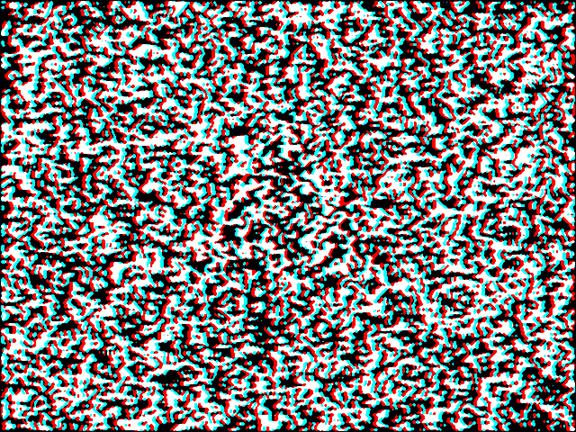
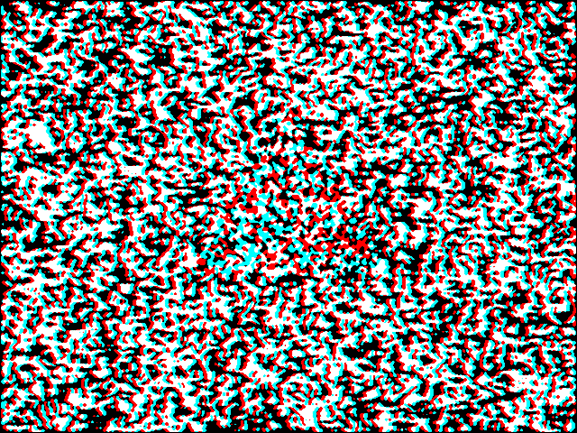
隱藏三角形的隨機點立體圖 隱藏三角形的隨機點相關圖
Hidden
triangle random point 3D graphic Hidden triangle random point related diagram
空間域 隨機點相關圖
(Spatial Random-dot Correlogram)
一般人對於隱藏三角形或方形的隨機點相關圖會感覺形狀是浮出於背景之前。如過隱藏的圖形是西洋棋盤,前景的面積和背景的面積相等,是不是仍然有西洋棋盤浮出來的感覺呢?請看,左圖是隱藏著西洋棋盤的隨機點立體圖,右圖是隱藏著西洋棋盤的隨機點相關圖。
People
generally perceive hidden triangular or square shapes in random dot patterns as
appearing in front of the background.If
the hidden shape is a checkerboard, and the foreground and background areas are
equal, will the checkerboard still appear to float out? Please see the left
image, which is a 3D random dot pattern hiding a checkerboard, and the right
image, which is a random dot pattern related image hiding a checkerboard.Hidden triangular random dot patterns
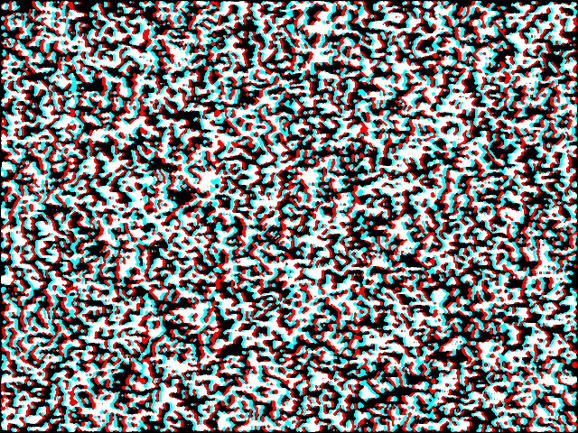
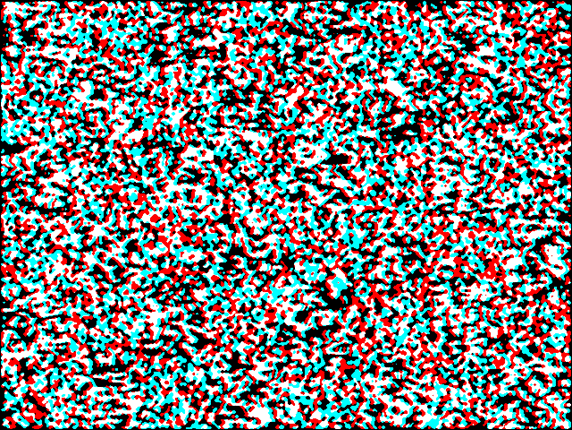
隱藏西洋棋盤的隨機點立體圖 隱藏西洋棋盤的隨機點相關圖
空間域 隨機點相關圖
(Spatial Random-dot Correlogram)
Hidden
random dot stereogram of a chessboard Hidden random dot image related to a
chessboard
Spatial
random-dot correlogram
人類大腦計算隨機點相關圖裡隱藏的圖形的能力似乎是計算隨機點立體圖浮出的形狀的先置步驟。視覺科研學者無論是心理物理學(psychophysics)或是電生理(electrophysiology)的研究,常將隨機點相關圖作為雙眼融合(fusion)的研究工具;而將隨機點立體圖作為立體視(stereopsis)的研究工具。融合是比較初階的雙眼視覺,而立體視則是最高檔的雙眼視覺。
The
ability of the human brain to compute hidden shapes in random dot stereograms
seems to be a prerequisite step for computing the emerging shapes of random dot
stereograms. Visual researchers, whether in psychophysics or electrophysiology,
often use random dot stereograms as a tool for studying binocular fusion; while using random dot stereograms as a tool for
studying stereopsis. Fusion is a more basic form of binocular vision, while
stereopsis is the highest-level form of binocular vision.
使用隨機點圖樣作視覺科研的趣味,除了隨機點立體圖、隨機點相關圖的雙眼視覺研究之外,隨機點動畫圖(Random-dot Kinematogram,RDK)則是研究單眼形覺(form vision)的有力工具。
Using random dot patterns for visual
research is fun. Besides random dot stereograms and random dot correlation
studies of binocular vision, random dot motion stimuli (random-dot
kinematograms, RDK) are powerful tools for studying
form vision.
隨機點動畫圖請見另文介紹 – http://homepage.ntu.edu.tw/~ahwang/RDK/Random-dot%20kinematogram.htm
Random dot animation can
be found in a separate article – http://homepage.ntu.edu.tw/~ahwang/RDK/Random-dot%20kinematogram.htm
和隨機點立體圖左、右兩眼各看一張半立體圖的情況類似,隨機點動畫圖在時間1、時間2所見的圖形(見圖)。
Similar
to the
situation where the left and right eyes of a random dot stereo are viewed with
a semi-stereoscopic image, the random dot animation diagram is seen at time 1
and time 2 (see figure).
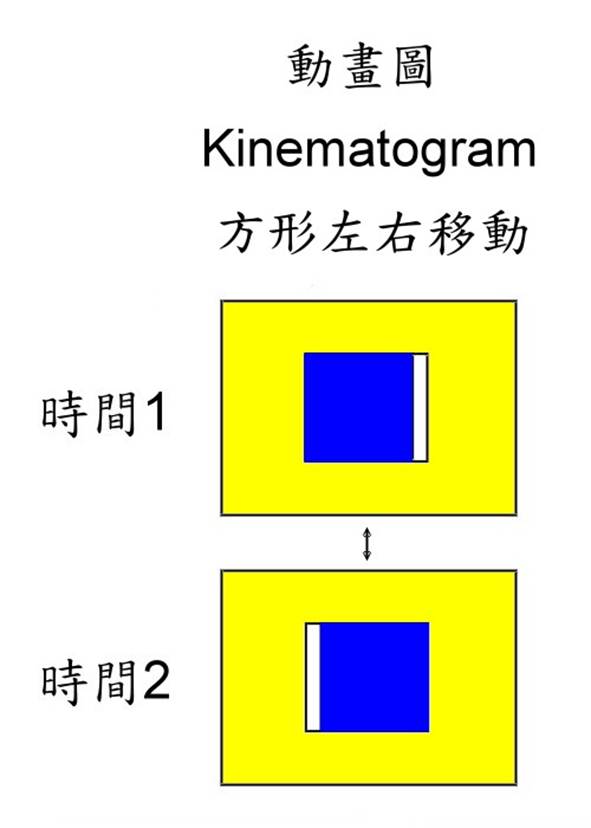
時間1和時間2的圖形往復播放,就看到一個方塊在向左、向右往復地移動(見圖)。
Time 1 and Time 2 are reciprocated, and a square is seen moving back and
forth to the left and right (see image).
時間1和時間2各自的隨機點圖都看不到方形,在往復播放的過程中,大腦是以什麼樣的機制去計算,解析出這個方形呢?
Time 1
and Time 2 do not see the square in the random dot plot, in the process of
reciprocating playback, what kind of mechanism does the brain use to calculate
and parse this square?
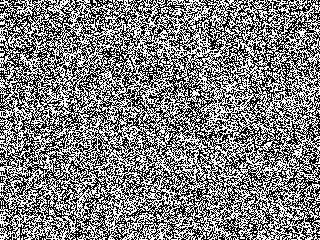
和隨機點立體圖相應和的隨機點相關圖,是空間域裡的相關圖(Spatial
correlogram)。如果將空間域隨機點相關圖左、右眼的兩張圖放在時間1和時間2往復播放,就得到時間域的隨機點相關圖(Temporal
correlogram)(見圖)。
The
random point correlation graph corresponding to the random point sterelogram is the spatial correlogram. If the two images
of the left and right eyes of the spatial domain random point correlation graph
are played back and forth in time 1 and time 2, the random point correlation
graph of the time domain (see figure) is obtained.
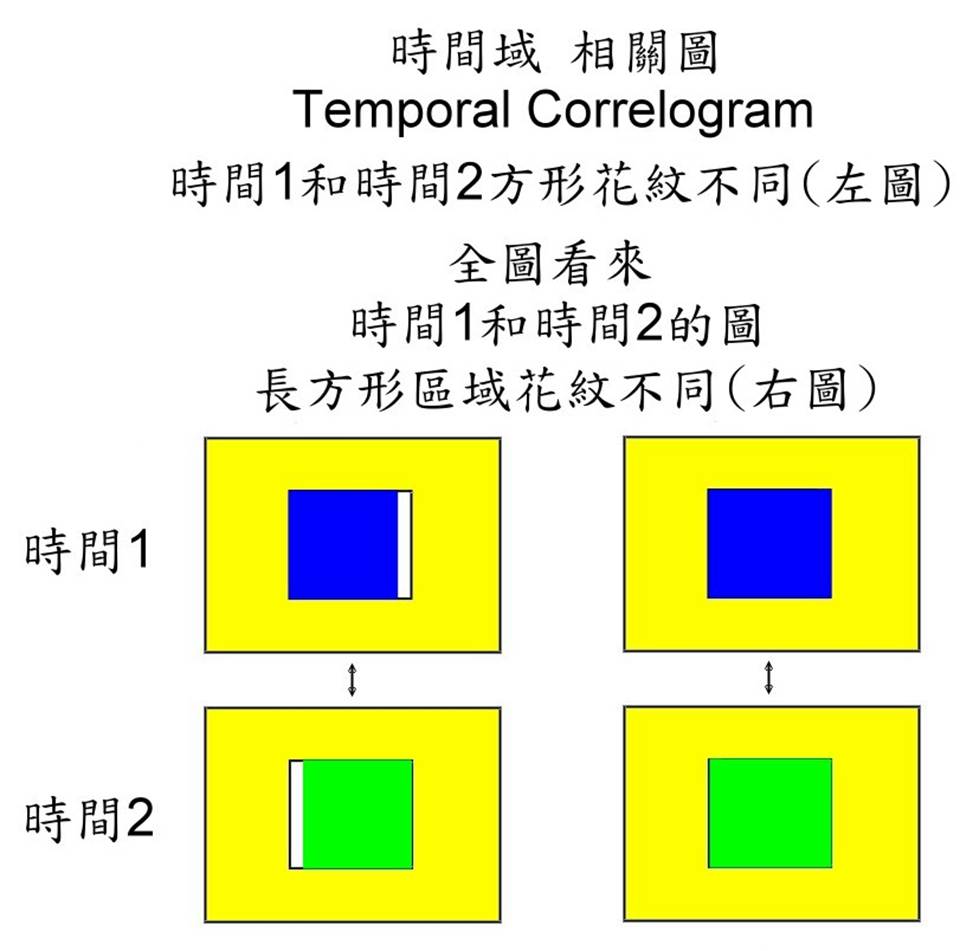
時間域的隨機點相關圖看不到方形向左、向右的運動(motion),但是大腦依然可以計算出一個閃爍著的長方形的形狀(見圖)!
The
random point correlation diagram of the time domain does not see the motion of
the square to the left and right, but the brain can still calculate the shape
of a shimmering rectangle (see figure)!
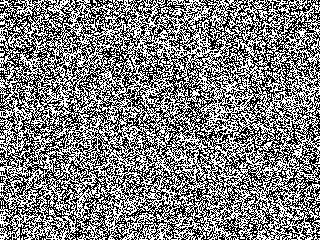
隨機點動畫圖和時間域的隨機點相關圖除了研究單眼的形覺之外,也研究運動覺(motion
perception)。哈佛大學心理系教授Ken
Nakayama指出,運動覺是應該要獨立於形覺之外,單獨研究、討論的課題。
In
addition to the morphology of SLRs, random point animation plots and random
point correlation plots in the time domain also study motion perception. Ken
Nakayama, a professor in the Department of Psychology at Harvard University,
pointed out that kinesthesia is a topic that should be studied and discussed
separately from form sense.
Nakayama K.
Biological image motion processing: a review. Vision
Res. 1985;25(5):625-60.
https://www.ocf.berkeley.edu/~knakayama/wp-content/uploads/2019/03/038visionres85b.pdf
有一點要注意的是,運動覺是一種知覺(sensory,afference),而不是眼球運動或肢體運動的運動(motor,efference),中文裡兩者都是“運動”,容易混淆。
One
thing to note is that kinesia is a kind of perception
(sensory, afference), not eye movement or limb movement (motor, efference),
both in Chinese are "movement", easy to confuse.
這是一張隨機點動畫圖 (Random-dot Kinematogram)(見圖),每一瞬間的方塊都是相同的隨機點花樣,沿著橢圓的軌道運行。
This
is a Random-dot Kinematogram (see image) where the
blocks are the same random dot pattern for each instant, running along an
elliptical track.
每一瞬間的畫面(電影膠片的每一個影格)都看不見方形,但是一旦電影開始播放,方形就變得清晰可見。
Every
moment of the frame (every frame of the film clip) is not visible, but once the
film starts playing, the square becomes clearly visible.
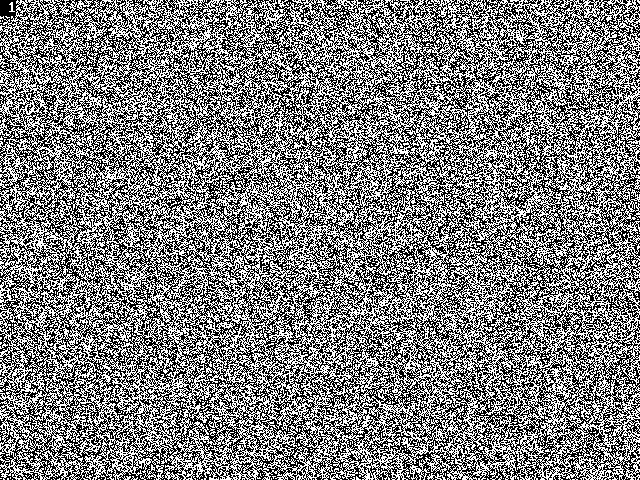
這一張是時間域的隨機點相關圖
(Temporal Random-dot Correlogram)(見圖),每一影格的方形的隨機點花樣都不一樣,但是影片開始播放之後,依然可以看見方塊的形狀,依然看到它沿著橢圓軌道在運行。
This
is a Temporal Random-dot Correlogram (see image), with a different random dot
pattern for each frame, but after the video starts playing, you can still see
the shape of the square, and you can still see it moving along an elliptical
orbit.
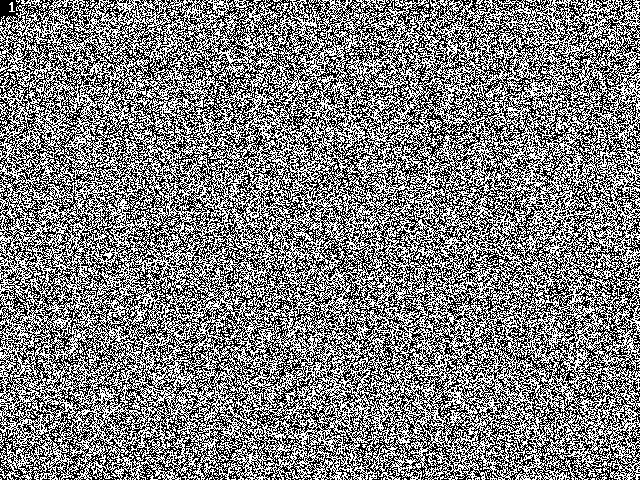
目前我檢查斜弱視病人的雙眼視,除了測試來自於雙眼像差的立體視(disparity
stereopsis)之外,也測試來自兩眼所見運動向量的運動立體視(motion stereopsis),依產生的機制來命名,它也叫做Binocular
Depth-from-Motion (BDFM)。
At
present, I examine the binocular stereopsis of patients with strabismus and
amblyopia, and in addition to the disparity stereopsis from binocular
aberrations, I also test the motion stereopsis from
the motion vectors seen in both eyes, named after the mechanism of production,
which is also called Binocular Depth-from-Motion (BDFM).
我們注視一個東西,它在空間裡向著不同的方向移動,在兩眼的網膜上會產生不同的兩個運動向量的組合(見圖)。反過來說,由兩眼網膜上不同的運動向量的組合,是有足夠的資訊去計算、去感知這個東西在空間上移動的方向和深度,這就是運動立體視。它和大家所熟悉的、由像差而來的立體視是要分別、分開來測試的。
When
we look at something, it moves in different directions in space, creating
different combinations of two motion vectors on the omentum
of both eyes (see figure). On the other hand, the combination of different
motion vectors on the retina of the two eyes has enough information to
calculate and perceive the direction and depth of the movement of this thing in
space, which is motion stereoscopia. It is tested
separately from the familiar stereoscopic vision derived from aberrations.
左邊的圖 – 在時間1,由像差線索是凸出的方形;在時間2,由像差線索是凹下的方形。單看右眼,是有運動線索的動畫圖;單看左眼,是和右眼運動方向相反的動畫圖。兩眼同時看,看到一個方形在深度上前後跳動。來自於像差的線索,也來自於運動的線索。
The
image on the left – at time 1, the disparity cue is a convex square; at time 2,
the disparity cue is a concave square. Viewed with the right eye, it's an
animated figure with motion cues; viewed with the left eye, it's an animated
figure with motion cues in the opposite direction. Seen with both eyes, a
square appears to jump back and forth in depth. The cues come from both
disparity and motion.
中間的圖 – 在時間1,由像差線索是凸出的方形;在時間2,由像差線索是凹下的方形。單看右眼,是時間域的相關圖;單看左眼,也是時間域的相關圖,兩眼各自都沒有左、右移動的運動線索。兩眼同時看,看到一個方形在深度上前後跳動,那是完全來自於像差的線索,沒有運動的線索。
Middle
diagram – at time 1, the aberrations of the cue are convex squares; At time 2,
the lead by aberration is concave square. Looking at the right eye alone, it is
a correlation graph of the time domain; Looking at the left eye alone, it is
also a correlation graph of the time domain, and there are no movement clues
for left and right movement in each eye. When you look at both eyes at the same
time and see a square bouncing back and forth in depth, that's a clue that
comes entirely from aberrations, and there is no clue to movement.
右邊的圖 – 在時間1,是空間域的相關圖;在時間2,也是空間域的相關圖。停格在時間1或時間2都沒有像差,都沒有深度覺。單看右眼,是有運動線索的動畫圖;單看左眼,是和右眼運動方向相反的動畫圖。兩眼同時看,看到一個方形在深度上前後跳動。那是完全來自於運動的線索,沒有像差的線索。
The
image on the right – at time 1, it's a spatial correlation diagram; at time 2,
it's also a spatial correlation diagram. Pausing at time 1 or 2 shows no
aberration, no depth perception. Viewing with the right eye only, there's a
motion cue animation; viewing with the left eye only, there's an animation with
motion in the opposite direction to the right eye. Viewing with both eyes
simultaneously, a square is seen jumping back and forth in depth. That's
entirely from motion cues, with no aberration cues.
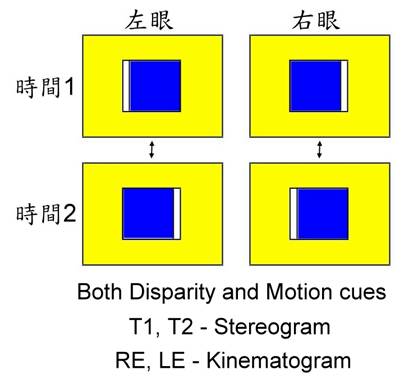
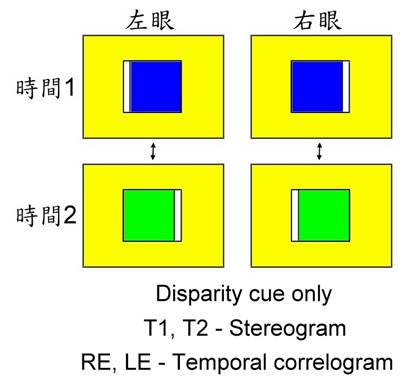
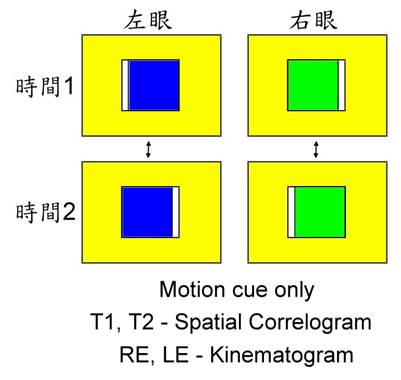
有像差線索,也有運動線索的隨機點立體圖
(Both Disparity and Motion cues)
There are aberration cues, as well as random point
stereograms of motion cues
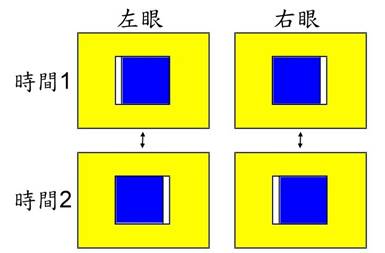
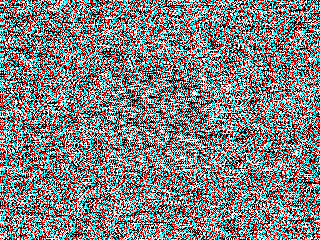
僅有像差線索,沒有運動線索的隨機點立體圖
(Disparity cue only)
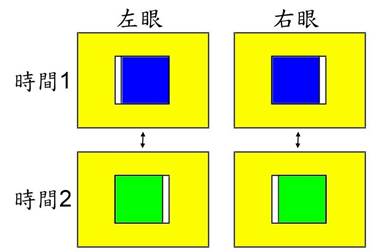
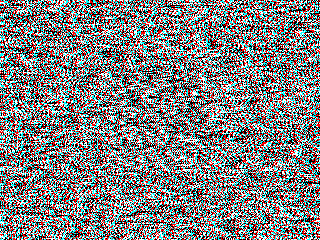
沒有像差線索,僅有運動線索的隨機點立體圖
(Motion cue only)
